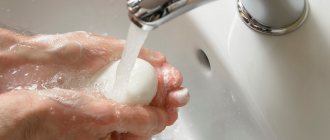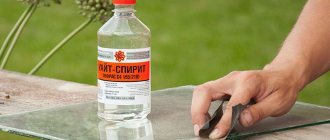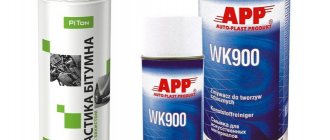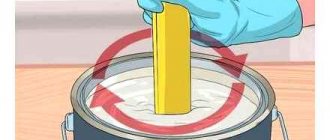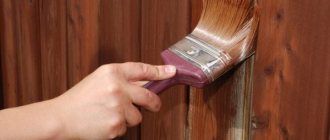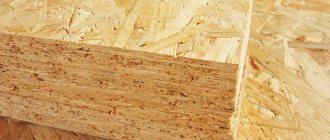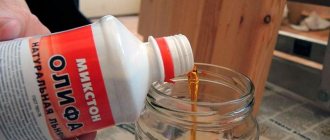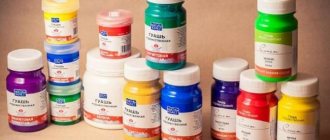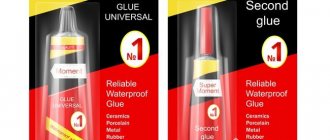Auto magazine
Nobody wants to worsen the situation by deforming spare parts – purchased or those to which they are attached.
People are especially sensitive to the paintwork of a car - repainting the entire body is expensive, time-consuming and troublesome if you do it with your own very skillful hands. But the body has to be degreased not only during repairs, but also if you are lucky enough to pick up water-insoluble contaminants on the road, such as drops of bitumen, rubber crumbs, all kinds of lubricants and oils, which are quite difficult to wash off from the body or glass. Can be degreased with white spirit
– the answer is first of all broken down into separate options based on the material from which the degreased surfaces are made. Based on this, we will describe these possibilities and feasibility of using this solvent in practice.
All modern chemicals used for degreasing are essentially solvents for organic matter and, accordingly, should not disturb inorganic surfaces (primarily metal ones). Antique and proven degreasers - gasoline with kerosene and acetone - coped with their role quite well, but were rejected by the modern automotive community due to their increased flammability. White spirit is also not devoid of it, but it is much less volatile, and therefore more correct from a safety point of view to use.
It does not react with metals, so there is no danger of using it to make a hole in the side of your iron friend.
White spirit does not dissolve the body coating, even if they are no longer solid and have scratches and abrasions. Taking into account its low price - 50 rubles per liter - most car owners prefer to use it for garage needs. The only drawback of the substance is its rather strong and persistent characteristic odor. With caution, white spirit can only be applied to aluminum parts and alloys containing this metal. Aluminum is easily corroded by certain organic compounds.
In theory, white spirit should not damage such parts, but who knows what is mixed into the source material. In any case, in folk auto practice there have been cases of deformation of aluminum parts.
The situation with him is much more complicated. There are many types of plastic used in the automotive industry. Some bubble and warp from benzene or acetone, others are driven in all directions by gasoline, and even dissolve in dichloroethane. A number of plastic parts are quite indifferent to white spirit, and they can be degreased with it. But it’s better not to experiment and buy a special, mild preparation like PiTon
or
APP WK900
. And it’s better to first test them on some inconspicuous area and in a microscopic dose.
Glass is also indifferent to more aggressive liquids than white spirit, and is overly cautious here. The question is: why is degreasing carried out? If its purpose is bonding (for example, when replacing a cracked rear view glass), then white spirit is quite suitable. But if you wash your windshield from oily substances before tinting or gluing a film, then it is better to turn your attention to other solvents.
The fact is that white spirit leaves behind quite noticeable, slightly oily stains. It is especially undesirable to use it under film - such patterns will remain with you forever. And even though they are not very noticeable, visibility will still be slightly impaired.
If we summarize the experience of many generations of car enthusiasts, then the question of whether it is possible to degrease with white spirit can definitely give a positive answer. You just need to do this necessary and painstaking process in a well-ventilated garage or even outside, in the open air. And it wouldn’t hurt to wear a special protective mask or respirator.
All modern chemicals used for degreasing are essentially solvents for organic matter and, accordingly, should not affect inorganic surfaces (primarily metal ones). Antique and proven degreasers - gasoline with kerosene and acetone - would cope with their role, but are rejected by the modern automotive community due to their increased flammability. White spirit is also not devoid of it, but it is much less volatile, and therefore is more correct from the point of view of safety in use.
So is it possible to degrease absolutely all surfaces with white spirit?
Quite often during repair work the question arises: is it possible to degrease this part with white spirit, or is a different solvent required?
Since a car enthusiast, as a rule, deals not only with metal, the answer in most cases will be ambiguous. Indeed, in addition to metal surfaces, the driver often has to bring glass and plastic products into proper shape. And in each individual case, the degreasing process will proceed somewhat differently.
a metal with white spirit - the answer will be in the affirmative. Yes, you can. Moreover, if the car body is being prepared for painting, this product is perfect for preparatory work. It can do the following.
- Remove all contaminants accumulated by the body during the operation of the car (mastic stains, rubber and bitumen deposits).
- Remove traces of coolants and lubricants, as well as all kinds of oils, from parts.
This, in fact, is the process of degreasing.
Are there any side effects from such operations? There is a minor drawback: after degreasing, small stains may remain at the work site. However, if painting is expected in the future, then this drawback is generally insignificant.
What about plastic ? Can it be degreased with white spirit? In principle it is possible. It must be remembered that this reagent has a much more gentle effect on almost all objects, unlike, say, reagents such as gasoline, kerosene, acetone, benzene, etc. However, you should not work at random. There are cases where some types of plastic warped and deformed after degreasing with white spirit. Therefore, it is better to talk with drivers who already have experience in such work and get the necessary information from them.
As for glass , the situation with degreasing is simpler. Glass is neutral to almost all aggressive liquids (with the exception of hydrofluoric acid, etc.).
But now is the time to remember the small drawback of the product mentioned above. If there is a need to clean the windshield or side glass of oil-containing substances, it is better to use another solvent that does not leave streaks.
But for removing fat before gluing parts, this reagent is quite suitable.
Can rubber be degreased with white spirit? This is also possible, but with caution; it is better to try this first on a small area of the part or even use gasoline.
Leave a reply Cancel reply
- About tuning General questions
- GAS
- VAZ
- UAZ
- We can do it ourselves
- Cons and conclusions
- Cleaning equipment
Recent comments
- Vadim on Reviews of eco-leather car covers
- Teor21 on Real reviews from owners about the Lada Vesta car, disadvantages and disadvantages
- Alexander on Real reviews from owners about the Lada Vesta car, disadvantages and disadvantages
- Vladimir K. on What can you say about LYNX shock absorbers?
- Back to post Latest news about customs clearance in Armenia in 2020, calculator and rates
Write to us
Your message has been successfully sent. Thank you!
What's better?
Which is better - white spirit or kerosene degreaser? Is it possible to ensure high-quality adhesion by replacing materials? Let us remember the fundamental differences between one fraction and another - volatility and viscosity. Kerosene is low-volatile and “heavy” compared to the “white spirit”. It is an excellent solvent, but due to its low volatility it forms a thin, oily film after degreasing, which, of course, does not contribute to better adhesion of the paintwork and the body surface.
Kerosene does not react with fabric dyes and does not damage wool pile. Why? Because it cannot interact with the smallest oxide compounds that cover all objects in contact with the atmosphere. We live in this very atmosphere! The surface of the car is also covered with exactly the same oxide film, which means that it must either be gotten rid of or made safe and “obedient”.
Nefras, like kerosene, is not able to rid the surface of the car of this film, but it is able to react with it and turn the harmful oxide into a stable chemical compound that does not interfere with adhesion.
Nefras “Galosha” - another version of white - is applicable not only for automotive iron, but also for vulcanizing its “shoes”.
The oxide film can be completely removed only with pure alcohol C₂H₅OH, but can you imagine the consumption of “spiritus” on a car body? The conclusion suggests itself: white spirit for degreasing before painting has clear advantages over kerosene and alcohol.
How to clean bitumen from a car (1 video)
What is defatting
The essence of the procedure is to remove fatty substances from the surface of the substrate, which are often present in cooling emulsions, mineral oils, preservative lubricants, and polishing compounds. Degreasing of the metal surface before painting also has to be done to remove residues from washing and etching, traces of sweat and fingers. All these contaminants can extremely negatively affect the quality of surface wetting with paints and varnishes, as well as harm film formation and other properties of the coating.
Depending on the amount of fatty impurities present per square meter, several degrees of surface contamination can be distinguished:
- Weak - up to 1 g;
- Medium - from 1 to 5 g;
- Increased - more than 5 g.
When processing fats with chemical reagents, several sequential processes occur on the surface:
Depending on the ability of fats to be destroyed under the influence of solvents, several types of contaminants are distinguished:
- Non-destructible - for example, emulsions.
- Pollinated - polishing materials, lubricant residues.
Chemical methods
The main type is organic solvents, which allow you to quickly remove grease and oily areas from metal parts. They are most widely used in individual production, although sometimes they are used in serial production, but not often due to their high explosion and fire hazard. The desired effect, namely the dissolution of oil and fat deposits, is achieved at the moment of contact of organic solvents with them.
The quality of surface degreasing is directly affected by the degree of solvent contamination, since the more fats are contained on the surface, the worse the chemical’s ability to dissolve existing deposits becomes. Most often, aliphatic and chlorinated solvents are used to remove fat and oil areas. Despite their high efficiency in metal cleaning, they have a serious drawback - these compounds are not able to remove abrasive materials and other mineral contaminants from the surface.
Aqueous solutions
As is known, water has poor purification ability, which is associated with significant surface tension and incompatibility with fats. Therefore, when it wets greasy surfaces, stable emulsions are not formed. To increase the cleaning properties of an aqueous solution, manufacturers resort to various techniques - increasing the pH acidity level, increasing the temperature regime of use to the range of 50-65 degrees Celsius, and introducing surfactants into the composition.
Alkaline degreasers
These compounds have a lot of positive properties. These include high cleaning ability, fire safety, environmental friendliness, and a wide selection of application methods. When treated with aqueous solutions of saponified fats and oils, the latter are inevitably destroyed, and unsaponifiable contaminants are emulsified. The latter case can be described as the process of detachment of fatty layers from the surface with gradual transformation into a working liquid and removal along with the working solution. The main disadvantage of these compositions is the need for anti-corrosion treatment of the surface after cleaning.
Read also: Diold Pre hammer drill 7 reviews
Among the components present in cleaning solutions, surfactants - surfactants - deal best with fatty and oily areas. Once on the surface, they form foam on it, simultaneously reducing interfacial and surface tension, increasing wettability and destroying solid and liquid contaminants, transforming them into a more convenient form for removal. The surfactant content in grease cleaners , as a rule, fluctuates within 10%.
If the need arises, along with degreasing, to remove thin oxide or hydroxide films, acidic solutions containing 1-3% phosphoric acid are used.
After treating surfaces with cleaning compounds, they must be washed with water. The presence of salt residues is unacceptable, since they can destroy the properties of paint films, increasing moisture permeability and accelerating the development of under-film corrosion.
Emulsion compositions
In cases where there is a need to remove oil deposits, grease, and difficult-to-remove contaminants from the surface, emulsion degreasing is used. This method is combined and has the advantages of organic solvents and aqueous alkaline solutions. These compositions contain emulsions of solvents and surfactants diluted with water. Chlorinated or aliphatic hydrocarbons can be used as solvents.
Ultrasonic and electrochemical methods
To increase the cleaning ability of detergent compositions, special baths with an ultrasonic field are used. This method is most relevant for small-sized products with a highly complex surface, for which it is important to remove contaminants with the highest quality possible. For large parts, it is not practical to use this method due to economic considerations, since there is a need to increase the output power of the device.
When preparing metal products using the electrochemical degreasing method, specially equipped baths are also used, and the process itself is carried out due to the action of gas bubbles formed on the electrodes. This makes it possible to reduce the consumption of components of chemical compositions and improve the quality of surface treatment.
Degreasing metal surfaces
Degreasing consists of removing conservation oils, cutting fluids, paint residues, and various stains from the surface. The importance of this stage cannot be underestimated. Especially when it comes to preparing a metal surface for painting. After all, only a perfectly clean surface can be considered the key to high-quality painting.
White spirit is widely used in the process of preparing a car body for painting. As a rule, it is necessary to remove contaminants such as bitumen, rubber, and mastic stains. Kerosene was previously used for these purposes. White spirit also belongs to the so-called light kerosene. However, there is a significant difference between them.
After degreasing the body surface with white spirit, most of the solvent evaporates. Part of the substance in the form of a film that remains on the cleaned surface does not impair the quality of painting. Regular or heavy kerosene is not removed as easily without consequences. In addition, it is difficult to wash off with water.
Experienced craftsmen practically no longer use acetone or gasoline to degrease the body. These substances are highly flammable. In contrast, white spirit, having less pronounced volatile properties, is a safer product to use for such purposes. In addition, it is chemically neutral to metal and does not pose any danger to it.
Another important advantage of this solvent is that it does not dissolve the paintwork of the body, even if there are scratches and abrasions. Therefore, most body painters use white spirit. When working with it, you must follow a number of rules, which will be discussed below.
Necessity of procedure and methods
Degreasing is a process during which the often invisible layer of oil or fat is completely washed away from the surface. Contaminants reach the substrate in a variety of ways. All products that are prepared for paint application undergo this treatment.
This procedure can be performed using various methods, not all of them are suitable for home use. The quality of the result and the complexity of the work depend on the correct choice of means.
There are several basic cleaning options that can be performed separately or in combination, which allows you to achieve the desired result even with heavy contamination.
- Mechanical.
This method is labor-intensive and time-consuming. Used to obtain a rough base that gives better grip. The layer of contamination is removed using electric and manual tools. This option does not give an ideal result, so it is often complemented by other methods.
For mechanical cleaning, you can use a grinder or a drill with special attachments, a hand-held metal brush, as well as ordinary chemical sandpaper. The most popular method to degrease the desired element. This is explained by the fact that the work process does not require much physical effort and does not take much time.
During this procedure, the selected liquid product is applied to the surface. Depending on the degree of exposure, the substance washes away oils and fats or destroys their structure.
Chemical degreasers are divided into two main types: organic and inorganic
- Electrochemical. This option is subject to special conditions that are only available to industrial enterprises. The bottom line is that the base is exposed to an electric charge and certain chemicals. The method allows for complete cleaning, but any deviations from the technology lead to damage to the processed metal.
At home, a good result can be achieved using chemical compounds; a mechanical method is used as a preliminary cleaning procedure. This allows you to paint the metal surface without further problems.
Types and composition of degreasers
Degreasing agents can be divided into three groups according to their chemical composition:
- Based on organic solvents - organic degreasers;
- Emulsion degreasers based on emulsions of organic solvents in water;
- Based on aqueous solutions of alkalis and acids - alkaline and acidic degreasers.
Organic degreasing agents are based on solvents - petroleum products (petroleum solvents), saturated and aromatic hydrocarbons, alcohols and esters, chlorinated hydrocarbons (methylene chloride, tri- and tetrachlorethylene, chlorofluorocarbons), white spirit and others. The degreaser may contain one or two solvents, as well as components to reduce the rate of evaporation of solvents, stabilize them, etc.
Advantages of using it before painting
Due to tightening production standards and the need to comply with GOST, the appearance of improved versions of materials has become the norm. This trend has also affected nefras. Consumers should pay attention to a solvent such as white spirit 1050.
The production of this substance is carried out, in particular, by. A certificate confirming quality determines the highest class of its products. The features of the solvent white spirit 1050 are the following:
- Effective. It is also used for diluting various paints and varnishes of the Tikkurila brand.
- The shelf life of white spirit 1050 solvent in the original container is at least 10 years, even at low temperatures.
- Contains paraffin and various compounds containing this substance in smaller quantities relative to analogues. This became possible due to the optimization of the chemical composition of the solvent by employees. Since paraffin is contained in smaller quantities, white spirit becomes safer for use.
- Less solvent consumption per nominal weight of paint and varnish material.
- Use for degreasing a larger list of surfaces compared to analogues.
- De-scented (odorless white spirit).
- Certificate guaranteeing the quality of the product.
- The specific gravity for 1050 nefras is 0.780 g/cm 3, which is less than the standard weight of a substance made in accordance with GOST requirements.
Information! There are different types of solvent, their technical characteristics, such as weight, volume of paraffin-containing additives, consumption, differ, but not too much.
Welcome to our site!
When comparing solvent and white spirit, you must immediately make a reservation that these are two solvents with similar properties, which are produced mainly from crude oil by distilling it in cracking columns at oil refineries. Without access to oxygen, at temperatures from 130 to 150C, hydrocarbons are evaporated, from which a solvent (solvent) is produced. In the same cracking columns, mixtures of hydrocarbons called white spirits are evaporated at temperatures from 155 to 200C. Aromatic hydrocarbons are evaporated from oil at low temperatures and in solvent form up to 56% of the total mass. The mass of such hydrocarbons in white spirit should not exceed 16%.
In addition to oil cracking, the production of solvent is established when producing coke from coal, when light aromatic fractions of hydrocarbons are released when heated in the form of coke oven gas, collected when passing through an exhaust pipe, condensed while passing through coolers, and the output is xylene, quite suitable for consumption, toluene and solvent. This coke oven gas contains up to 60% light aromatic hydrocarbons. Due to the higher content of aromatic hydrocarbons, the solvent, unlike white spirit, has a sharper characteristic odor, which evaporates quite quickly, however, when working with the solvent for a long time in a closed, unventilated room, it can cause a headache and even hallucinations in a person.
The content of hydrocarbons of different volatility gives both solvents slightly different properties, for example, solvent may have a yellowish tint, white spirit is always transparent, solvent dries within 10-20 minutes, white spirit dries within 1-2 hours, solvent gives paints a glossy surface , and White Spirit makes the paint matte with an additional film on top. Solvent has found application not only for diluting paints, it is also actively used for cleaning metal parts (including car bodies) before painting them. White spirit is more actively used by paint manufacturers and consumers at home. Similar properties include the ability of both solvents to dissolve oil paints and fats. In addition to oil paints, the solvent dissolves nitro paints well. Both solvents are used in the production of glyphthalic, pentaphthalic, alkyd and bitumen paints and varnishes, when removing old dried paints and when removing grease stains before painting. Due to its low odor and low drying speed, white spirit is more actively used in the production of paints. Using solvents, rubbers, bitumens and polyesteramides are dissolved. Sometimes solvent is used to obtain poison from rats and beetles, but this is rather an exception.
Read also: Melting point of the most refractory metal
Both solvents are flammable substances with a low flash point, and both have the ability to accumulate static electricity, which can cause an explosion. The density of the solvent is higher than the density of white spirit, and they are 0.86 and 0.79, respectively.
Despite assurances of development and improvement of the quality of both solvents, at the moment not a single oil refinery in the Russian Federation produces solvents that comply with GOST 1978 and 1979, which determine their regulatory compliance. This happened for a number of reasons:
- GOST allowed the presence of aromatic hydrocarbons, which made both solvents so odorous that they did not find their use abroad, that is, they are not sold for export. Western analogues do not have the smell and color, which is provided for in the regulations of these countries, so our solvents are very inferior to them.
- Increasing consumer demands for solvents has led to an increase in the flow of imported solvents. Transparent and completely odorless solvent produced at coal processing plants in Alsace and White Spirit distilled in Norway greatly displaced the production of domestic solvents, making its production unprofitable.
- The deepening of the oil refining process created conditions when it became possible to distill the fraction of solvents and white spirits with a boiling point from 120 to 200C into more expensive benzenes and gasolines, replacing solvents with inexpensive orthoxyols and toluenes. Today, the production of solvent and white spirit according to GOST standards is not economically profitable, and all oil refineries that sell solvents produce them based on their own specifications. Such solvents do not have the density of the declared solvents and have overly strong odors.
- Modern developments in chemistry have made it possible to obtain solvent and white spirit by simply mixing various hydrocarbons. As a result, it turned out to be much easier and cheaper to achieve the properties of solvents by adding various hydrocarbons than to carry out complex and costly oil refining processes.
- Many manufacturers are trying to replace solvent and white spirit with various kerosene-based solvents. Such attempts are quite successful and will probably soon make it possible to completely abandon the centuries-old dependence on petroleum solvents.
The need to prepare metal products for painting is due to an increase in the adhesion characteristics of the substrate to the paint and varnish material and the resistance of the metal to corrosion processes. All this will have a positive effect on the service life of the painted products. However, most owners are much more concerned about the presence of rust, which must be removed during the metal preparation process, than about degreasing, which is why painting work is carried out without this important and mandatory operation.
How to degrease metal before painting
Car degreasers
In everyday life, the choice of degreasing agent most often falls on the old “old-fashioned products” - gasoline, kerosene, acetone, alcohol. Nefras (White Spirit) and Solvent 646 are considered more modern and technologically advanced. They are distinguished by their low price, better environmental friendliness and form films that are neutral to the paintwork, which prevents corrosion. In order for the substrate to match the selected paint after degreasing, it is advisable to buy the solvent that is suitable for the coating (the manufacturer writes the numbers of suitable solvents on the label). At the same time, according to consumer reviews, No. 646 remains the most universal. Special Anti-Silicone solvents are used by craftsmen to degrease the car body before subsequent painting. Of course, we should not forget about safety - work with organic solvents should be carried out in a room with good ventilation, away from sources of ignition, using personal protective equipment.
Popular solvents
Many home craftsmen and car owners who repair their cars themselves are wondering how to degrease parts before painting. In addition to time-tested products, more effective formulations are available today.
White spirit
White spirit enjoys well-deserved popularity. It is a clear, uncolored liquid with a strong odor typical of petroleum products. One of the commercial names under which it is presented on the market is “Nefas C4”.
It is universal in use and is highly effective. It is capable of degreasing any grease and fatty compounds, as well as many organic substances. Excellent for thinning most oil-based paints. Therefore, after applying it to the part, you do not need to wait for it to dry completely, but you can immediately begin applying primer or paint. The product differs from other formulations in its high evaporation rate. When using white spirit, it is also necessary to thoroughly ventilate the room and use personal protective equipment.
Solvent 646
This composition has a yellowish tint and a pungent odor. It was originally positioned as a paint thinner, but is also successfully used to degrease metal parts. Excellent for removing old layers of paint from parts, for washing brushes, rollers and other painting equipment.
The best compatibility is achieved with the following types of paints:
- based on nitrocellulose (labeling NC);
- glypthal (GF);
- based on epoxy resins
- acrylic;
- melaninoamide (MP);
Solvent 646
The composition has certain restrictions on the conditions of use. It can best degrease when:
- temperature +5 - +30 °C;
- relative air humidity less than 85%.
In this case, the metal acquires shine and gloss and no rainbow stains remain.
When working with this effective and popular product, it is worth remembering that it is flammable and harmful to health. Personal protective equipment is required: gloves, goggles, respirator. It is strictly prohibited to use open fire, including smoking, within 5 meters of the work site. The room must be well ventilated or equipped with exhaust ventilation.
Acetone - classic
Acetone is one of the classic, decades-tested means for removing oil and grease stains and deposits. It is a volatile, transparent, colorless liquid with a sharp, characteristic odor. Acetone can degrease vegetable, animal and mineral oils and resins.
The substance is widely used for diluting paints and varnishes. It is used both in pure form and as part of other solvents, for example, together with alcohol.
Acetone
Due to the exceptional volatility of the liquid, when working with acetone, it is necessary to carefully observe safety precautions - do not use open flames, do not smoke, use safety glasses and gloves, and a respirator. You should not bend over a container with acetone - involuntary inhalation can cause dizziness and even loss of consciousness.

